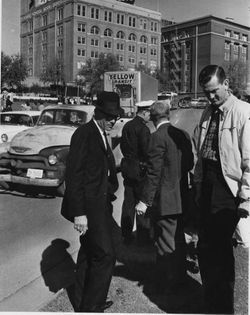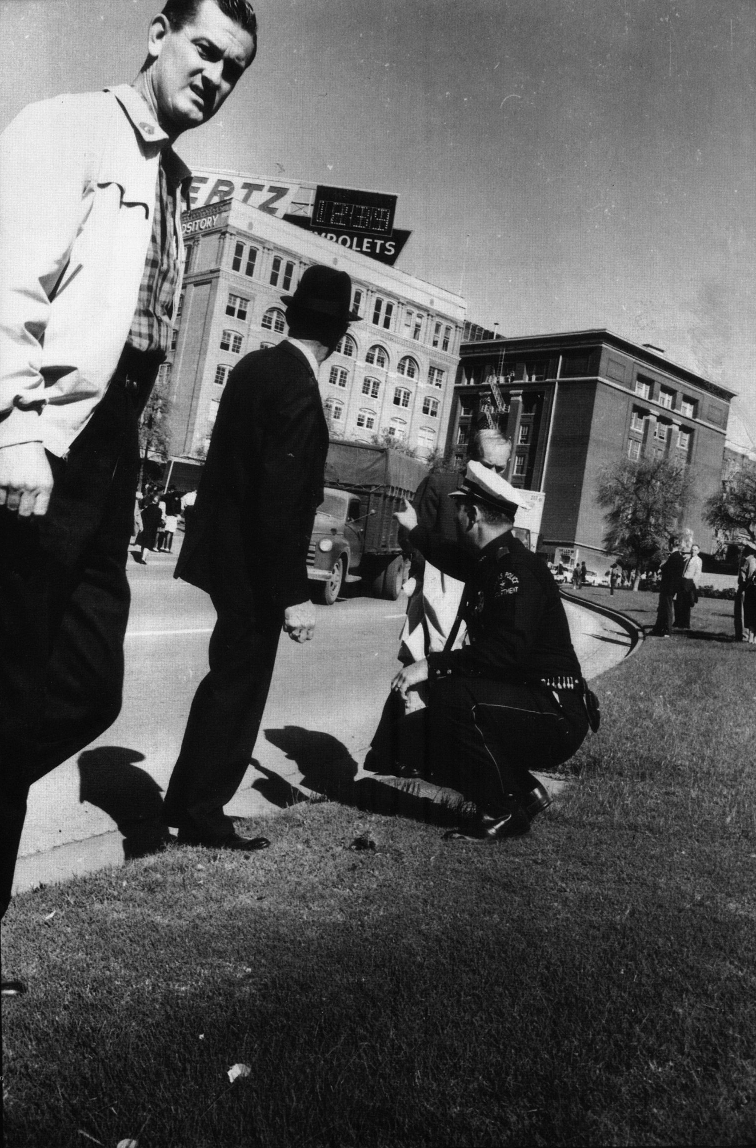Wayne Eldridge Hartman married Edna Mae McCartney in Palm Beach Florida in 1945, where she had moved from her native Pennsylvania. They then moved to Springfield, Ohio, Warren, Ohio, Greenwood, Indiana and finally Irving, Texas - a Dallas suburb - where they remained until their passing.
Edna and Wayne Hartman were key witnesses to the assassination of President John F. Kennedy - witnessing a burrow created by a missed shot that hit and raised up the turf near the curbside manhole cover on the south side of Elm Street in Dealey Plaza.
On 11/22/63, the Hartmans had been at Mullendorf's Cafe on Main St. near Dealey Plaza when they heard that the Presidential motorcade would soon pass by the cafe. They went outside and stood at the N.E. corner of Main and Record to watch the motorcade, then returned to the cafe. Within minutes they heard loud gunshots and immediately went outside and proceeded down Main St. to Dealey Plaza where they saw generalized chaos and encountered a policeman and a small boy on the Grassy Knoll.
Edna Hartman later recalled to JFK author, Jim Marrs, "He [the policeman] pointed to some bushes near the railroad tracks on the north side of the street and said that's where the shots came from... Then I noticed these two parallel marks on the ground that looked like mounds made by a mole. I asked, 'What are these, mole hills?' and the policeman said, 'Oh no, ma'am, that's where the bullets struck the ground'" (Marrs, Crossfire, 315-16).
Amateur assassination photographer Hugh Betzner noticed "police officers and some men in plain clothes . . . digging around in the dirt as if they were looking for a bullet" there (http://jfk.ci.dallas.tx.us/12/1261-001.gif). And professional photographers Jim Murray and William Allen took a famous sequence of photos showing Dep. Sheriff E. R. "Buddy" Walthers (in civilian clothes) watching as a blonde-haired man, he believed to be an FBI agent, pointed at the dug-out spot on the ground just off Elm Street, bent over, scooped something up from the turf, then put the item in his pocket. Shown the photos, Dallas Police Chief, Jesse Curry, said the man was an FBI agent, but he didn't know his name. Later he said he knew his name but wouldn't divulge his name. Some have identified him as FBI Special Agent Robert Barrett (since disproved), others as FBI Agent Kenneth "Prince" Albert (the agent has a very strong likeness to his yearbook photos). The photographs have been widely published.
Murray also photographed the hole that was left in the turf after the scene had been cleared; this photograph ran in the following day's Fort Worth Star-Telegram, captioned, "One of the rifle bullets fired by the murderer of President Kennedy lies in the grass across Elm Street . . ." The Dallas Times-Herald reported in reference to the hole in the grass, "Dallas Police Lt. J. C. Day of the crime lab estimated the distance from the sixth-floor window . . . to the spot where one of the bullets was recovered at 100 yards."
In 1964 the Hartman's responded to an FBI request to the public for witnesses to contact them with information. The FBI did not take their statement until July 1964 (CD 1518). Edna said when the they went to the FBI to volunteer their detailed observations the FBI acted like their observations were not important to the FBI or the investigation, and that it did not matter to the FBI whether the HARTMAN's made a statement or not. Edna said the FBI dismissively told them that the bullet track was caused by "pieces of bone from the skull of the president," but Edna said "I told them I did not believe a bone could do all of that." And "The angle it (the bullet track) was, it could not have been from the President's skull".
The Hartman's told the FBI the hole as about 1 1/2" in diameter and the burrow as shallow, not going down into the earth, but running just under the roots of the grass for about 18-24 inches. They described its direction as being from the Grassy Knoll toward the south, ie: toward Main Street. (This would be perpendicular to the direction of a missed shot had it been fired from the Texas School Book Depository.)
In 1982, Dallas Morning News reporter, Earl Golz, interviewed the Hartmans for his book writing that the Hartman's said the bullet track was "...not in line with the shots fired from the depository building..." but was "...aligned in the direction of the grassy knoll across the street and to the right front of the limousine."
When JFK reseacher/author, Jim Marrs, interviewed the Hartmans for his 1989 book "Crossfire" he shared with them the content of their FBI Statements for the first time and were furious to learn that their statements had been altered by the FBI, without their knowledge or permission to state the burrow created by the missed shot led back in the direction of the Texas School Book Depository - something they never said and directly opposed to the direction of the burrow they saw on 11/22/63.
In her videotaped interview with JFK researcher, Mark Oaks, in 1991, Mrs. Hartman specifically said the direction of the furrow led back to the area "by a large tree above the Grassy Knoll," where it has long been posited there was another assassin.
Audio excerpt of Edna's 1991 interview by JFK Researcher, Mark Oakes:
https://www.youtube.com/watch?v=UtFoPCKVp-8&feature=youtu.be&t=265
Edna & Wayne Hartman's altered 8/10/64 FBI Statements (CD 1518, Scroll down slightly): http://jfkassassinationfiles.com/cd1518
Wayne Eldridge Hartman married Edna Mae McCartney in Palm Beach Florida in 1945, where she had moved from her native Pennsylvania. They then moved to Springfield, Ohio, Warren, Ohio, Greenwood, Indiana and finally Irving, Texas - a Dallas suburb - where they remained until their passing.
Edna and Wayne Hartman were key witnesses to the assassination of President John F. Kennedy - witnessing a burrow created by a missed shot that hit and raised up the turf near the curbside manhole cover on the south side of Elm Street in Dealey Plaza.
On 11/22/63, the Hartmans had been at Mullendorf's Cafe on Main St. near Dealey Plaza when they heard that the Presidential motorcade would soon pass by the cafe. They went outside and stood at the N.E. corner of Main and Record to watch the motorcade, then returned to the cafe. Within minutes they heard loud gunshots and immediately went outside and proceeded down Main St. to Dealey Plaza where they saw generalized chaos and encountered a policeman and a small boy on the Grassy Knoll.
Edna Hartman later recalled to JFK author, Jim Marrs, "He [the policeman] pointed to some bushes near the railroad tracks on the north side of the street and said that's where the shots came from... Then I noticed these two parallel marks on the ground that looked like mounds made by a mole. I asked, 'What are these, mole hills?' and the policeman said, 'Oh no, ma'am, that's where the bullets struck the ground'" (Marrs, Crossfire, 315-16).
Amateur assassination photographer Hugh Betzner noticed "police officers and some men in plain clothes . . . digging around in the dirt as if they were looking for a bullet" there (http://jfk.ci.dallas.tx.us/12/1261-001.gif). And professional photographers Jim Murray and William Allen took a famous sequence of photos showing Dep. Sheriff E. R. "Buddy" Walthers (in civilian clothes) watching as a blonde-haired man, he believed to be an FBI agent, pointed at the dug-out spot on the ground just off Elm Street, bent over, scooped something up from the turf, then put the item in his pocket. Shown the photos, Dallas Police Chief, Jesse Curry, said the man was an FBI agent, but he didn't know his name. Later he said he knew his name but wouldn't divulge his name. Some have identified him as FBI Special Agent Robert Barrett (since disproved), others as FBI Agent Kenneth "Prince" Albert (the agent has a very strong likeness to his yearbook photos). The photographs have been widely published.
Murray also photographed the hole that was left in the turf after the scene had been cleared; this photograph ran in the following day's Fort Worth Star-Telegram, captioned, "One of the rifle bullets fired by the murderer of President Kennedy lies in the grass across Elm Street . . ." The Dallas Times-Herald reported in reference to the hole in the grass, "Dallas Police Lt. J. C. Day of the crime lab estimated the distance from the sixth-floor window . . . to the spot where one of the bullets was recovered at 100 yards."
In 1964 the Hartman's responded to an FBI request to the public for witnesses to contact them with information. The FBI did not take their statement until July 1964 (CD 1518). Edna said when the they went to the FBI to volunteer their detailed observations the FBI acted like their observations were not important to the FBI or the investigation, and that it did not matter to the FBI whether the HARTMAN's made a statement or not. Edna said the FBI dismissively told them that the bullet track was caused by "pieces of bone from the skull of the president," but Edna said "I told them I did not believe a bone could do all of that." And "The angle it (the bullet track) was, it could not have been from the President's skull".
The Hartman's told the FBI the hole as about 1 1/2" in diameter and the burrow as shallow, not going down into the earth, but running just under the roots of the grass for about 18-24 inches. They described its direction as being from the Grassy Knoll toward the south, ie: toward Main Street. (This would be perpendicular to the direction of a missed shot had it been fired from the Texas School Book Depository.)
In 1982, Dallas Morning News reporter, Earl Golz, interviewed the Hartmans for his book writing that the Hartman's said the bullet track was "...not in line with the shots fired from the depository building..." but was "...aligned in the direction of the grassy knoll across the street and to the right front of the limousine."
When JFK reseacher/author, Jim Marrs, interviewed the Hartmans for his 1989 book "Crossfire" he shared with them the content of their FBI Statements for the first time and were furious to learn that their statements had been altered by the FBI, without their knowledge or permission to state the burrow created by the missed shot led back in the direction of the Texas School Book Depository - something they never said and directly opposed to the direction of the burrow they saw on 11/22/63.
In her videotaped interview with JFK researcher, Mark Oaks, in 1991, Mrs. Hartman specifically said the direction of the furrow led back to the area "by a large tree above the Grassy Knoll," where it has long been posited there was another assassin.
Audio excerpt of Edna's 1991 interview by JFK Researcher, Mark Oakes:
https://www.youtube.com/watch?v=UtFoPCKVp-8&feature=youtu.be&t=265
Edna & Wayne Hartman's altered 8/10/64 FBI Statements (CD 1518, Scroll down slightly): http://jfkassassinationfiles.com/cd1518
Inscription
HA1 U.S. NAVY
WORLD WAR II
Family Members
Sponsored by Ancestry
Advertisement
Advertisement





